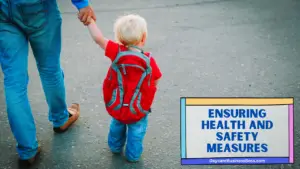Welcome to the realm of nurturing and educating young minds right in your living room. Setting up a home daycare is a fulfilling adventure that combines the joy of childcare with the chance to form the basis of early childhood education. Whether you’re a parent hoping to provide a caring environment for your child or an aspiring caregiver looking to provide a haven for others, the setup of your home daycare is critical to achievement.
To best ensure the effectiveness of your home daycare, you should consider creating a safe play area, setting a structured daily schedule with learning and nap times, offering age-appropriate activities and toys, ensuring health and safety measures, and fostering open communication with parents.
In this article, we will dig into the area of home daycare setup ideas, examining the key components that can transform your room into a lively hub of learning, exploration, and growth. Whether you’re a seasoned educator or just getting started, these ideas will inspire and encourage you to create an environment where children can grow, learn, and build lasting experiences.
Creating a Safe Play Area

The construction of a safe and appealing play environment is a critical factor when creating a home daycare. Safety comes first, but also honoring young children’s natural curiosity and inquisitive inclination. Designating a separate location within your home that mitigates potential threats becomes critical. This entails a rigorous process of removing sharp objects, securing electrical outlets, and protecting against choking hazards. A well-planned layout, combined with the installation of safety gates and childproof locks, creates a controlled atmosphere in which children can play freely while providing caregivers with peace of mind.
When it comes to curating the play area, providing age-appropriate toys takes center stage. These toys serve as catalysts for the development of creativity, imagination, and motor skills. By carefully picking toys that correspond to children’s developmental phases, you not only improve their cognitive development but also create a foundation for holistic development. Consider introducing soft mats or rugs to enhance the play experience by not only providing a comfortable surface but also reducing the effect of falls during playtime.
In the joy of play, children’s safety is vital. Regular inspections of toys and equipment are required to detect any signs of wear or damage that could jeopardize the children’s safety. Proactively removing or correcting potentially hazardous things demonstrates a vigilant dedication to their safety.
Read more about: Child’s Play, Owner’s Gain: Making Daycare Centers Sustainable
Setting a Structured Daily Schedule
The importance of a regular daily program at the heart of a healthy home daycare cannot be emphasized. It serves as a solid basis for the growth and development of youngsters. Routine and predictability feed young minds, providing them with a soothing sense of security and stability in their surroundings. Creating a well-planned timetable necessitates meticulous preparation that takes into account the changing demands of these motivated students.
The orchestration of specified study times, play sessions, meal intervals, and nap periods within this timetable creates a harmonious rhythm that affects children’s experiences. The planned routine goes beyond simply allocating time; it serves as a conduit for youngsters to grasp the flow of their day, promoting a sense of expectation and comfort. This routine helps toddlers to explore their world with confidence by offering a constant foundation.
The incorporation of age-appropriate learning activities is essential to this regimen. Because young minds are predisposed to assimilate information, including interactive learning opportunities becomes an essential component. Captivating storytelling, imaginative arts and crafts projects, and basic yet exciting science experiments grab their interest and inspire their natural drive to learn. These activities perfectly combine instruction and entertainment, transforming learning into an enjoyable trip rather than a chore.
A well-balanced daily plan includes both playtime and learning time. The combination of these two elements ensures a comprehensive development strategy. Play promotes social interaction, imaginative discovery, and physical development, whereas learning activities promote cognitive development and emotional intelligence. Striking this balance allows children to realize their full potential across numerous dimensions, ensuring that no aspect of their development is overlooked.
Offering Age-Appropriate Activities and Toys
The careful selection of age-appropriate activities and toys is essential in creating a productive and enriching home daycare environment. It acknowledges that different age groups’ growth trajectories are as variable as the children themselves. By personalizing your products to these specific developmental demands, you establish the framework for an experience that is both engaging and favorable to learning.
With their keen eyes and developing senses, infants require toys that are gentle on their sensitive faculties. In this period, soft toys, mobiles, and sensory play items take center stage. These objects pique their interest, encouraging sensory exploration and early cognitive development. Gentle play with these items lays the groundwork for their understanding of their surroundings.
When a child enters the toddler stage, his or her cognitive abilities and interests change. Toys that inspire imaginative play, develop fine motor abilities, and aid in problem-solving take center stage here. Whether it’s building blocks that encourage creativity or puzzles that boost cognitive development, each item serves as a stepping stone on their developmental path.
Incorporating instructional materials into the mix enhances the learning experience even more. Colorful pages and fascinating storytelling in age-appropriate books boost language acquisition and imagination. Puzzles and building blocks go beyond simply entertainment, encouraging critical thinking and spatial awareness. Cognitive development is encouraged organically and interestingly through these activities.
Accepting outside playtime adds another degree of enrichment. Nature’s treasures become a canvas for discovery, where children may practice gross motor skills, grasp cause and effect, and enjoy the fresh air. Outdoor playtime is more than simply a break; it is a comprehensive engagement that promotes physical, cognitive, and emotional development.
Ensuring Health and Safety Measures

When it comes to operating a home daycare, the most important things to think about are the children’s health and their safety. Stringent health and sanitation standards must be adhered to at all times to protect not only the young charges but also the caregivers. These kinds of safety measures not only act as an efficient barrier against the spread of infections but also foster an atmosphere that is beneficial to one’s development and education.
An essential component of this devotion is a steadfast adherence to health recommendations that emphasize the significance of routinely washing one’s hands. The importance of keeping surfaces and toys clean cannot be overstated when attempting to cut down on potential sources of infection. These efforts not only result in an environment that is clean and sanitary, but they also demonstrate a dedication to safeguarding the health of everyone who is involved in the situation.
Being well-prepared for unexpected events is an essential part of maintaining one’s health and safety. By establishing unmistakable guidelines for addressing various types of medical crises, caregivers provide the groundwork for a prompt and efficiently organized response. When it comes to being prepared, you really must ensure that your location has a first aid kit that is filled. The ability of caregivers to provide rapid treatment when it is required instills trust in both the children and the parents. Understanding basic first aid protocols enables carers to deliver prompt treatment.
It is essential to carefully keep all of the data up to date. By keeping a record of children’s medical histories, allergens, and emergency contacts, caregivers can ensure that they are equipped with the vital knowledge necessary to make quick and accurate judgments if an emergency arises. When parents know that you are this well-prepared, they can entrust their children to your care without experiencing any anxiety.
Read more about: Child’s Play, Maximum Safety: The Definitive Daycare Playground Checklist
Fostering Open Communication with Parents
A thriving home daycare is built on solid foundations, not simply elements, and effective communication with the parents is one of those cornerstones. The fact that parents put their faith in you to look out for the health and safety of their children highlights how important it is to keep communication channels open and honest at all times. When this is done, you are laying the framework for a solid and long-lasting foundation of trust that is beneficial to the development of both children and their parents.
Multiple goals can be accomplished by providing parents with consistent updates on their children’s daycare experiences, including details on the activities, achievements, and even difficulties that their children confront. It provides parents with insights into their child’s developmental journey while also keeping parents informed about the daily interactions of their child. This transparency not only helps to build a sense of inclusion but also helps to reinforce the idea that you are dedicated to providing attentive and all-encompassing care to all of your patients.
Providing opportunities for parents to have an active role in the activities and decisions that pertain to their child’s daycare experience is an essential component of good communication. You may cultivate an atmosphere in which parents feel emboldened to share their ideas by providing channels via which criticism, questions, and concerns can be voiced. This engagement, which goes in both directions, not only gives parents a chance to express their opinions but also gives you important information about the demands and requirements they have.
The scope of communication can be expanded beyond the exchange of day-to-day updates when regular parent-teacher conferences are held. These meetings offer a dedicated forum in which to discuss the progression of children, the developmental milestones they have reached, and any areas that may require more focus. These kinds of conversations allow parents to actively participate in the educational path of their children while also facilitating a greater grasp of the growth trajectory of each child.
The true power rests in the cooperative and encouraging atmosphere that is fostered by efficient communication. You can turn a child’s daycare experience into a cooperative effort between the child, the child’s parents, and the child’s caregivers by inviting the parents to participate in their child’s care. Children flourish when they are provided with comprehensive care and attention that is caring, while parents derive reassurance from their active involvement. Caregivers also gain valuable insights from the interactions they have with the children.
Frequently Asked Questions

How can I assure children’s safety in my home daycare?
A safe environment is essential for a home daycare. Begin by establishing a safe play space devoid of hazards including sharp items and choking hazards. To block access to potentially harmful areas, install safety gates and childproof locks. Inspect toys and equipment for wear and damage regularly, and remove any things that could pose a concern. To keep a clean and healthy atmosphere, follow strict hygiene measures such as handwashing and sanitization. Establish clear standards for dealing with medical emergencies, as well as keep up-to-date medical records for each child.
What should a home daycare structured daily program include?
A regular daily schedule is vital for keeping youngsters in a balanced and interesting environment. Create a schedule that includes periods for learning activities, playtime, meals, and naps. Begin with a friendly morning ritual to help youngsters adjust to their new childcare environment. Include age-appropriate learning activities that foster cognitive and social growth. Encourage physical exercise and exploration by providing outside playing. Maintain consistent nap periods and a peaceful setting for slumber. A well-structured routine provides stability and security to children.
How can I communicate effectively with parents of children in my home daycare?
Communication with parents must be open and transparent for a home daycare to be effective. Establish clear communication routes, such as regular updates via SMS, emails, or a specialized communication app. Share information on your children’s everyday activities, accomplishments, and any difficulties they may be experiencing. Encourage parents to share their thoughts, ask questions, and express their concerns. Set up parent-teacher conferences regularly to discuss children’s progress and developmental milestones. Involving parents in their child’s daycare experience fosters trust and a supportive partnership centered on the child’s well-being.
To learn more on how to start your own daycare checkout my startup documents here.
The information provided by DaycareBusinessBoss.com (“The Site”) is for general informational purposes only. All information on the Site is provided in good faith, however, we make no representation or warranty of any kind, express or implied, regarding the accuracy, adequacy, validity, reliability, availability or completeness of any information on the Site. Under no circumstance shall we have any liability to you for any loss or damage of any kind incurred as a result of the use of the Site or Reliance on any information provided on the Site. Your use of the Site and your reliance on any information on the Site is solely at your own risk.
This blog post is for educational purposes only and does not constitute legal advice. Please consult a legal expert to address your specific needs. Terms and Conditions. (https://daycarebusinessboss.com/terms-conditions/)

Meet Shawn Chun: Entrepreneur and Childcare Business Fan.
I’m a happy individual who happens to be an entrepreneur. I have owned several types of businesses in my life from a coffee shop to an import and export business to an online review business plus a few more and now I create online daycare business resources for those interested in starting new ventures. It’s demanding work but I love it. I do it for those passionate about their business and their goals. That’s why when I meet a childcare business owner, I see myself. I know how hard the struggle is to retain clients, find good employees and keep the business growing all while trying to stay competitive.
That’s why I created Daycare Business Boss: I want to help childcare business owners like you build a thriving business that brings you endless joy and supports your ideal lifestyle.


